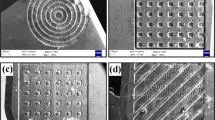Abstract
Fe-based amorphous alloy is a new-type material dedicated to the remanufacture due to its unique property. Fe-based amorphous alloy is deposited on the abrased, fatigued, and fractured surface for resuming and upgrading its performance. In the present research, properties of amorphous alloy overlay, such as the microstructure, the phase content, thermal behavior, and mechanical property were evaluated and its machinability with respect to machining forces was experimentally investigated. Based on the response surface methodology and Box–Behnken design, four-factor (cutting speed, feed, depth of cut, and rake angle) three-level experiments were applied and analysis of variance (ANOVA) was performed. It is found that depth of cut is the dominant cutting parameter that affects the machining force components. Rake angle and interaction of feed rate and depth of cut can provide secondary significance to machining forces. Cutting speed, alone, has insignificant influence on machining force components. Predicting model for machining forces is established. ANOVA indicates that a linear model best fits the radial force and while a quadratic model best describes the axial force and cutting force. The optimal cutting parameters under these experimental conditions are searched.
Similar content being viewed by others
References
Brožek M (2003) Turning of overlays using Kennametal Hertel tools. In 17th International Conference on Production Research, Blacksburg, VA, pp 1–6
Brožek M (2005) Cutting conditions optimization when turning overlays. J Mater Process Technol 168:488–495
Lalwani DI, Mehta NK, Jain PK (2008) Experimental investigations of cutting parameters influence on cutting forces and surface roughness in finish hard turning MDN 250 steel. J Mater Process Technol 206:167–179
Kishawy HA, Elbestawi MA (1999) Effect of process parameters on material side flow during hard turning. Int J Mach Tools Manuf 39:1017–1030
Huang Y, Liang SY (2003) Force modeling in shallow cuts with larger negative and large nose radius tools-applications to hard turning. Int J Adv Manuf Technol 22:626–632
Aresecularathe JA, Zhang LC, Mathew P (2006) On machining of hardened AISI D2 steel with PCBN tools. J Mater Process Technol 171:244–252
Fnides B, Yallese MA, Mabrouki T, Rigal J-F (2011) Application of response surface methodology for determining cutting force model in turning hardened AISI H11 hot work tool steel. Indian Acad of Sci 36(1):109–123
Ponnambalam V, Poon SJ, ShifeLet GJ (2004) Fe-based bulk metallic glasses with diameter thickness larger than one centimeter. Int J Mater Res 19(5):425–428
Cheng JB, Xu BS (2009) Formation and properties of Fe-based amorphous/nanocrystalline alloy coating prepared by wire arc spraying process. J Non-Cryst Solids 355:1673–1678
Thiele JD, Melkote SN (1999) Effect of cutting edge geometry and workpiece hardness onsurface generation in the finish hard turning of AISI 52100 steel. J Mater Process Technol 94:216–226
Thakur DG, Ramamoorthy B, Vijayaraghavan L (2009) Study on the machinability characteristics of superalloy Inconel 718 during high speed turning. Mater Des 30:1718–1725
Huang Y, Liang SY (2005) Modeling of cutting forces under hard turning conditions considering tool wear effect. ASME J Manuf Sci Eng 127:262–270
Chou YK, Evans CJ (1999) White layers and thermal modeling of hard turned surfaces. Int J Mach Tools Manuf 39:1863–1881
Gaitonde VN, Karnik SR, Luis Figueira J, Davim P (2009) Machinability investigations in hard turning of AISI D2 cold work tool steel with conventional and wiper ceramic inserts. Int J Ref Met Hard Mat 27:754–763
Author information
Authors and Affiliations
Corresponding author
Rights and permissions
About this article
Cite this article
Wang, M., Xu, B., Dong, S. et al. Experimental investigations of cutting parameters influence on cutting forces in turning of Fe-based amorphous overlay for remanufacture. Int J Adv Manuf Technol 65, 735–743 (2013). https://doi.org/10.1007/s00170-012-4212-2
Received:
Accepted:
Published:
Issue Date:
DOI: https://doi.org/10.1007/s00170-012-4212-2




